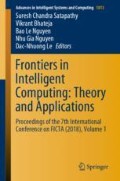Abstract
In this paper, anonymized mobile phone log data have been used to predict users’ personality in the context of Big5 model in a privacy-preserving manner. First, the Big5 concepts are presented. Afterwards, we present how to calculate Big5 indicators from the available mobile data sets. Hereafter, Big5 traits can be predicted based on those just-specified indicators. As a proof of our concepts, implementation results will be presented in the context of TB5 (Tracking Big5) tool, which has been designed and developed to predict Big5 personalities in a representative manner.
Access this chapter
Tax calculation will be finalised at checkout
Purchases are for personal use only
References
Alam, F., Stepanov, E.A., Riccardi, G.: Personality traits recognition on social network-facebook. In: Proceedings of Workshop on Computational Personality Recognition, AAAI Press, Melon Park, CA, pp. 6–9 (2013)
Chittaranjan, G., Blom, J., Gatica-Perez, D.: Who’s who with big-five: analyzing and classifying personality traits with smartphones. In: Proceedings of the 15th Annual International Symposium on Wearable Computers (ISWC ‘11), IEEE Computer Society, pp. 29–36 (2011)
CNN: Your phone company is selling your personal data. http://money.cnn.com/2011/11/01/technology/verizon_att_sprint_tmobile_privacy/index.htm (2011)
de Montjoye, Y.A., Smoreda, Z., Trinquart, R., Ziemlicki, C., Blondel, V.: D4D-Senegal: the second mobile phone data for development challenge (2014)
de Montjoye, Y.A., Quoidbach, J., Robic, F., Pentland, A.: P13. Predicting personality using novel mobile phone-based metrics (2013)
de Oliveira, R., et al.: Towards a psychographic user model from mobile phone usage. In: Proceedings of the 2011 Annual Conference Extended Abstracts on Human Factors in Computing Systems, ACM (2011)
Harari, G.M., Lane, N.D., Wang, R., Crosier, B.S., Campbell, A.T., Gosling, S.D.: Using smartphones to collect behavioral data in psychological science: opportunities, practical considerations, and challenges. Perspect. Psychol. Sci. J. Assoc. Psychol. Sci. (2016)
Hoang, A.D.T., Ngo, S.N., Nguyen, T.B.: Collective cubing platform towards definition and analysis of warehouse cubes. In: ICCCI, vol. 2, pp. 11–20 (2012)
Hoang, A.D.T., Nguyen, T.B.: An integrated use of CWM and ontological modeling approaches towards ETL processes. In: ICEBE 2008, pp. 715–720 (2008)
Hoang, A.D.T., Nguyen, T.B.: State of the art and emerging rule-driven perspectives towards service-based business process interoperability. In: RIVF 2009, pp. 1–4 (2009)
Howlader, P., Pal, K.K., Cuzzocrea, A., Madhu Kumar, S.D.: Predicting facebook-users’ personality based on status and linguistic features via flexible regression analysis techniques. In: Proceedings of the 33rd Annual ACM Symposium on Applied Computing (SAC ‘18). ACM, New York, NY, USA, pp. 339–345 (2018)
McCrae, R.R., John, O.P.: An introduction to the five-factor model and its applications. J. Pers. 60(2), 175–215 (1992)
Mount, M., Ilies, R., Johnson, E.: Relationship of personality traits and counterproductive work behaviors: the mediating effects of job satisfaction. Pers. Psychol. 59 (2006)
Nguyen, T.B., Ngo, N.S.: Semantic cubing platform enabling interoperability analysis among cloud-based linked data cubes. In: Proceedings of the 8th International Conference on Research and Practical Issues of Enterprise Information Systems, CONFENIS 2014, ACM International Conference Proceedings Series (2014)
Nguyen, T.B., Wagner, F., Schoepp, W.: EC4MACS—An integrated assessment toolbox of well-established modeling tools to explore the synergies and interactions between climate change, air quality and other policy objectives. In: ICT-GLOW 2012, pp. 94–108 (2012)
Nguyen, T.B., Wagner F., Schoepp W.: GAINS-BI: business intelligent approach for greenhouse gas and air pollution interactions and synergies information system, In: Proceedings of the International Organization for Information Integration and Web-based Application and Services, IIWAS 2008, Linz (2008)
Nguyen, T.B., Tjoa, A.M., Wagner, R.: Conceptual multidimensional data model based on metacube. Adv. Inf. Syst. 24–33 (2000)
Nguyen, T.B., Wagner, F.: Collective intelligent toolbox based on linked model framework. J. Intell. Fuzzy Syst. 27(2), 601–609 (2014)
Nguyen, T.B., Wagner, F., Schoepp, W.: Federated data warehousing application framework and platform-as-a-services to model virtual data marts in the clouds. Int. J. Intell. Inf. Database Syst. 8(3), 280 (2014)
Oberlander, J., Nowson, S.: Whose thumb is it anyway?: classifying author personality from weblog text. In: Proceedings of the COLING/ACL on Main Conference Poster Sessions (COLING-ACL ‘06). Association for Computational Linguistics, Stroudsburg, PA, USA, pp. 627–634 (2006)
Peng, K.H., Liou, L.H., Chang, C.S., Lee, D.S.: Predicting personality traits of Chinese users based on Facebook wall posts. pp. 9–14 (2015)
Tomlinson, M.T., Hinote D., Bracewell D.B.: Predicting conscientiousness through semantic analysis of facebook posts. In: Proceedings of Workshop on Computational Personality Recognition, AAAI Press, Melon Park, CA (2013)
Zhang, W., Gao, F.: An improvement to naive bayes for text classification. Procedia Eng. 15, 2160–2164 (2011)
Acknowledgments
Thanks to Orange Sonatel Senegal and the D4D team for providing the mobile phone data. Support from the Duy Tan University, Vietnam is acknowledged.
Author information
Authors and Affiliations
Corresponding author
Editor information
Editors and Affiliations
Rights and permissions
Copyright information
© 2020 Springer Nature Singapore Pte Ltd.
About this paper
Cite this paper
Nguyen, B.T., Dung, D.N., Thuy, H.N.T., Thi, T.H., Huong, L.P.T., Dinh, H.T. (2020). Tracking Big5 Traits Based on Mobile User Log Data. In: Satapathy, S., Bhateja, V., Nguyen, B., Nguyen, N., Le, DN. (eds) Frontiers in Intelligent Computing: Theory and Applications. Advances in Intelligent Systems and Computing, vol 1013. Springer, Singapore. https://doi.org/10.1007/978-981-32-9186-7_25
Download citation
DOI: https://doi.org/10.1007/978-981-32-9186-7_25
Published:
Publisher Name: Springer, Singapore
Print ISBN: 978-981-32-9185-0
Online ISBN: 978-981-32-9186-7
eBook Packages: Intelligent Technologies and RoboticsIntelligent Technologies and Robotics (R0)

